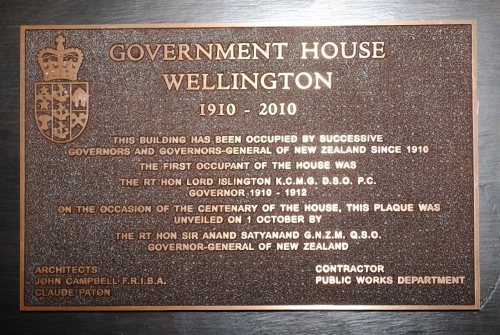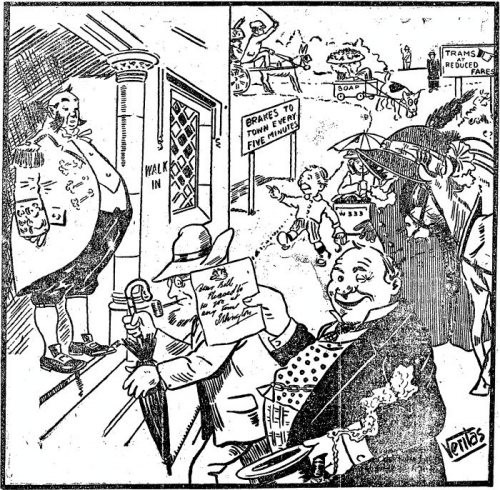
One hundred years’ of history was marked on 1 October 2010 when the then Governor-General, Rt Hon Sir Anand Satyanand, unveiled a plaque at Government House in Wellington to mark the centenary of the historic building.
While Government House was closed at the time for a major conservation project, more than a 100 guests entered the construction site for the event. After the unveiling, Sir Anand and Lady Susan Satyanand, hosted guests to a morning tea in the ballroom of the House. Guests included current and former Government House staff, former Governor-General, Sir Michael Hardie Boys, Minister of the Crown Hon Peter Dunne, members of Parliament and the judiciary, as well as mayors from throughout the Wellington region.
October 1 was chosen as the date to mark the centenary as historical records show that the first Governor to live in the House, Lord Islington, held a ministerial dinner on that night.
Government House Wellington and grounds have a fascinating history. Like the stories of many of New Zealand’s early colonial buildings, it was a fire that gave impetus to its construction.
In September 1907, New Zealand celebrated as it ceased to be Colony and became a Dominion of the British Empire. The wooden neo-Gothic Parliament Buildings were lit up with electric light to mark the occasion.
Less than three months later, on December 11, the buildings were again alight, but this time by a devastating fire that gutted the structure. The neighbouring Library building, which was of a similar style, only survived because it was made of concrete.
With nowhere for Parliament to meet, the ballroom of Government House, a wooden Italianesque building located where the Beehive now stands, was commandeered as the debating chamber. The Governor, Lord Plunket, went to live in Palmerston North, and was never to return to Government House, which later became the home of the parliamentary restaurant, Bellamys. The building was eventually demolished in 1969.
Several sites were considered before it was decided to locate Government House in Newtown, and construction began in 1908. The principal designer of the building was Claude Paton, the assistant of designed the Government Architect, John Campbell.
There is no record of the laying of a foundation stone or of the unveiling of a plaque to mark its opening. Why that should be so is not clear. Lord Plunket was certainly not keen on the site, stating that it was “some way from the principal government offices, in a less fashionable part of town.” Given the construction timetable, it was probably clear to him that he would never get to live in the new House.
It is more likely, however, that it was the death of King Edward VII in May 1910 that put paid to any plans for a grand opening. With the Royal Court being in full official mourning, gala events at Government House were ruled out.
Lord Plunket's successor, Lord Islington, arrived on June 22. Government House was not yet completed and he stayed at a house in Featherston. Lady Islington arrived in August of that year.
Lord Islington’s supposed displeasure at the state of House was reported in the media. The Governor took the unusual step of making a public statement that, while much work remained to be done on the grounds, he was very pleased with the House. He told theNew Zealand Press Association:
“There is absolutely no truth in the statements … Having travelled in most parts of the Empire, and seen most Government Houses, I can say that although the outward appearance of the Governor’s new residence in Wellington is not at present, perhaps, as attractive as it might be, as regards the interior arrangements and comforts, it compares more than favourably with any other Government House …. It is an excellent house, presenting a very stately appearance outside, and the interior is quite singular in its arrangements.”
Not everyone shared Islington’s enthusiasm. Wellington North MP Alexander Herdman, for example, described it as looking “like a glorified grain store.”
The Islingtons moved into the House in August and with Royal Court mourning ending on September 30 that year, the Governor hosted a ministerial dinner in the House on October 1. It is because of that event, that the centenary was marked on October 1.
The celebrations were to be short-lived. An outbreak of a mysterious illness, linked to the building’s drains and sewers, saw the Islingtons move out and stay in the countryside. Questions were raised in Parliament, and the Prime Minister, Sir Joseph Ward, had to defend the work done on the House, denying the illness was typhoid fever. MPs were so angry that they tried to cut the Government Architect’s salary by £1 in protest.
The Islingtons soon returned and by December were reported to have hosted a large reception, with the interior of the House being lauded by a reporter from The Evening Post:
“On entering the ballroom one was cheered by a sense of warmth and colour in contrast to the southerly ‘buster’ which prevailed outside: rich, crimson, brocaded curtains draped the windows, and the floor was covered by mole-coloured velvet pile carpet, and there were plenty of brilliant electric lights—altogether most attractive after the dark and stormy drive up to the house. The drawing rooms were most cosy and pretty—the floors all covered with deep rose-coloured carpets, the walls white, and decorated with many interesting pictures, among which were two beautiful black and white drawings of Lady Islington, by Sargent, and some lovely old engravings. There were so many interesting and charming things to look at: some pieces of tapestry, such as we never have an opportunity of seeing here, an autographed letter of Lord Nelson’s, beautiful paintings, and a most fascinating French clock on each mantelpiece. Flowers were in profusion everywhere, a particularly fine stand of gloxinias being at one end of the drawing room. There were many dainty and electric lamps standing about on the tables, with cream silk shades, and, in many cases, flowers banked round them with a very pretty effect.”
Lord and Lady Islington travelled widely throughout New Zealand, before he resigned in 1912 to become chairman of the Royal Commission on Public Service in India. Lord Islington was also keen on making Government House more open to a wider section of the public, which the New Zealand Truth satirised in rhyme and a cartoon:

The Guv’nor gave a party,
It was a swell affair,
Invitations were sent out
Here, there, and everywhere.
“It want to make you welcome all,”
His Lordship did declare,
“No one I’ll excuse, you must enthuse
At my great vice-regal ball.”There was Lizze from Newtown,
Who shook a giddy leg,
And shocked the toffs who came there
When Billy Brown a dance did beg
Such goings-on were awful, sure,
And then when pretty Meg
Got free with cham., and muttered “damn,”
The giddy throng fell thro’ the “flure.”The butlers were kept busy,
They had a roaring time,
Corks were popped and wine ran free.
Bill Brown said ‘twas sublime;
The blokes who came in donkey shays
Cried out “Give it a nime.”
His Ex. got vexed, and much perplexed—
And dropped this silly craze.”
Lord and Lady Islington were the first of 21 Governors or Governors-General to live in the House. Islington’s successor, the Earl of Liverpool, who served from 1912 to 1920, became the first Governor-General when new Letters Patent were issued in 1917.
When Lord Islington lived at Government House, the role of the Governor was vastly different from today's modern Governor-General. New Zealand was a colony and the Governors and early Governors-General were appointed on the advice of the British Government to not only undertake the duties of the Sovereign, but also to represent its interests and those of the British Empire. While there were regular functions at Government House, it was primarily a stately Edwardian home for the Governor and his family, that he largely furnished himself.
The British Empire is no longer and New Zealand is an independent nation. From an agent of a once global empire, the New Zealand Governor-General of the 21st Century is a New Zealander who represents the Head of State in New Zealand, and New Zealand to the rest of the world.
As the role of the Governor-General has changed, so has Government House. It is far more than a stately home. It is a fully serviced residence for the Governor-General and visiting dignitaries, an office for the Governor-General's staff, as well as a venue for formal events and ceremonies related to the Governor-General’s constitutional, ceremonial and community roles.
With the completion of the Conservation Project in 2011, the House, which has a category 1 rating from the NZ Historic Places Trust, is ready to face the next 100 years.
Speech given by Sir Anand Satyanand for the Government House centenary
